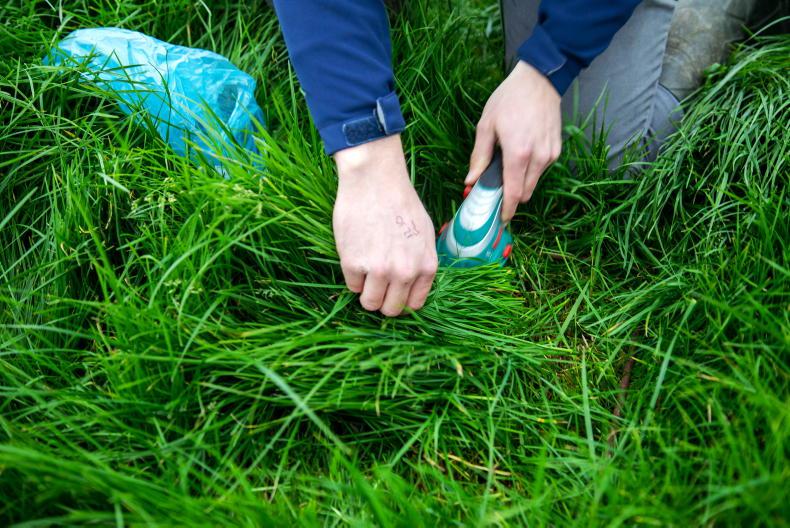Big regional differences are emerging in terms of soil moisture deficits. Looking at the Met Eireann map, Malin Head in Co Donegal has a soil moisture deficit of zero, meaning soils are at field capacity and cannot take any more moisture.
Meanwhile, there are large parts of the south east and a large area encircling Cork city where soil moisture deficits are greater than 50mm.
In my experience, a soil deficit in this range is enough to limit grass growth rates and is a cause for concern. There are plenty of farms outside of these regions where soil moisture deficits are also biting, but are more sporadic based on rainfall and soil type.
Curtins Farm in Moorepark has been struggling for grass for the last few weeks and have been getting away without feeding silage and large amounts of meal by having all of the farm available for grazing, meaning the demand is low.
Ordinarily, they would have land closed up for silage and reseeding at this time of year, but not this year.
In terms of actions, it’s a good decision as it limits the amount of feed that has to be fed and buys time for the situation to change, which it inevitably will.
However, the situation is likely to get worse before it gets better as there is little or no rain in the forecast and temperatures are set to increase this week, meaning evapotranspiration will be higher.
On farms where growth is lower than demand, action should only be taken if the average farm cover is lower than target.
Putting in extra feed and going on a long round length will hold average farm cover but I think its better to let average farm cover run down a bit before feeding heavy.
There is little value in putting in feed to hold on to grass which is deteriorating in quality the longer the rotation length goes.
I would think letting average farm cover go down to 120kg to 140kg per cow and then put in feed is a better approach than putting in feed when cover per cow is at 180kg or more.
How quickly cover per cow changes depends on the difference between growth and demand. On farms that have been struggling with growth for some time, they might very well be at the point where they have no choice but to feed heavy now.
On other farms that are only beginning to see growth rates drop, they should be able to hold off feeding for another few weeks and manipulate demand by increasing the area available for grazing such as cutting/grazing surplus paddocks, etc.
Big regional differences are emerging in terms of soil moisture deficits. Looking at the Met Eireann map, Malin Head in Co Donegal has a soil moisture deficit of zero, meaning soils are at field capacity and cannot take any more moisture.
Meanwhile, there are large parts of the south east and a large area encircling Cork city where soil moisture deficits are greater than 50mm.
In my experience, a soil deficit in this range is enough to limit grass growth rates and is a cause for concern. There are plenty of farms outside of these regions where soil moisture deficits are also biting, but are more sporadic based on rainfall and soil type.
Curtins Farm in Moorepark has been struggling for grass for the last few weeks and have been getting away without feeding silage and large amounts of meal by having all of the farm available for grazing, meaning the demand is low.
Ordinarily, they would have land closed up for silage and reseeding at this time of year, but not this year.
In terms of actions, it’s a good decision as it limits the amount of feed that has to be fed and buys time for the situation to change, which it inevitably will.
However, the situation is likely to get worse before it gets better as there is little or no rain in the forecast and temperatures are set to increase this week, meaning evapotranspiration will be higher.
On farms where growth is lower than demand, action should only be taken if the average farm cover is lower than target.
Putting in extra feed and going on a long round length will hold average farm cover but I think its better to let average farm cover run down a bit before feeding heavy.
There is little value in putting in feed to hold on to grass which is deteriorating in quality the longer the rotation length goes.
I would think letting average farm cover go down to 120kg to 140kg per cow and then put in feed is a better approach than putting in feed when cover per cow is at 180kg or more.
How quickly cover per cow changes depends on the difference between growth and demand. On farms that have been struggling with growth for some time, they might very well be at the point where they have no choice but to feed heavy now.
On other farms that are only beginning to see growth rates drop, they should be able to hold off feeding for another few weeks and manipulate demand by increasing the area available for grazing such as cutting/grazing surplus paddocks, etc.






 This is a subscriber-only article
This is a subscriber-only article










SHARING OPTIONS: